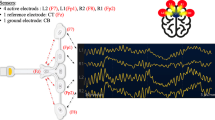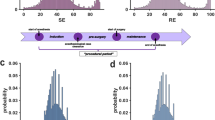Abstract
Background
The prototypical intracranial pressure (ICP) pulse morphology has been well known to be triphasic. Several studies suggest that the morphology of ICP pulse reflects the physiological and pathophysiological conditions of the intracranial dynamics. Recently, there has been a renaissance of studying ICP pulse using new ICP signal processing technologies in various clinical contexts. Cerebral blood flow velocity (CBFV) pulse is another important pulsatile signal originated from the complex circulatory systems of cerebral blood flow. However, CBFV pulse morphology has not been well studied mainly due to the noise level and lack of signal processing techniques.
Methods
Our group recently developed a technique called the morphological clustering and analysis of intracranial pressure that can extract a comprehensive set of pulse morphological metrics. We extend this algorithm to extract various morphological metrics from ICP and CBFV pulses that were simultaneously recorded from 47 brain injury patients and investigate the mutual correlation between those metrics utilizing the robust percentage bend correlation analysis.
Results
Our results show that CBFV pulses are also triphasic as ICP pulses and 15.2% of 128 pulse morphological metrics extracted from ICP and CBFV pulses are highly correlated (P < 0.01) in an inter-subject fashion. In addition, mean ICP does not correlate (P = 0.45) with the pulsatility index of CBFV pulses but correlates (P < 0.05) with several novel CBFV pulse morphological metrics such as the time interval between the onset of CBFV pulses and ECG QRS peak.
Conclusions
Our results suggest that characterizing CBFV pulse morphology is clinically important because it may offer a potential noninvasive alternative to assess various aspects of ICP such as mean ICP.







Similar content being viewed by others
References
Piper IR, Chan KH, Whittle IR, Miller JD. An experimental study of cerebrovascular resistance, pressure transmission, and craniospinal compliance. Neurosurgery. 1993;32(5):805–15; discussion 815–6.
Piper IR, Miller JD, Dearden NM, Leggate JR, Robertson I. Systems analysis of cerebrovascular pressure transmission: an observational study in head-injured patients. J Neurosurg. 1990;73(6):871–80. http://dx.doi.org/10.3171/jns.1990.73.6.0871.
Portnoy HD, Chopp M. Cerebrospinal fluid pulse wave form analysis during hypercapnia and hypoxia. Neurosurgery. 1981;9(1):14–27.
Hirai O, Handa H, Ishikawa M. Intracranial pressure pulse waveform: considerations about its origin and methods of estimating intracranial pressure dynamics. No To Shinkei. 1982;34(11):1059–65.
Balestreri M, Czosnyka M, Steiner LA, Schmidt E, Smielewski P, Matta B, Pickard JD. Intracranial hypertension: what additional information can be derived from icp waveform after head injury? Acta Neurochir (Wien). 2004;146(2):131–41. http://dx.doi.org/10.1007/s00701-003-0187-y.
Kirkness CJ, Mitchell PH, Burr RL, March KS, Newell DW. Intracranial pressure waveform analysis: clinical and research implications. J Neurosci Nurs. 2000;32(5):271–77.
Contant CF, Robertson CS, Crouch J, Gopinath SP, Narayan RK, Grossman RG. Intracranial pressure waveform indices in transient and refractory intracranial hypertension. J Neurosci Methods. 1995;57(1):15–25.
Matsumoto T, Nagai H, Kasuga Y, Kamiya K. Changes in intracranial pressure (icp) pulse wave following hydrocephalus. Acta Neurochir (Wien). 1986;82(1–2):50–6.
Eide PK. A new method for processing of continuous intracranial pressure signals. Med Eng Phys. 2006;28(6):579–87. http://dx.doi.org/10.1016/j.medengphy.2005.09.008.
Eide P, Brean A. Cerebrospinal fluid pulse pressure amplitude during lumbar infusion in idiopathic normal pressure hydrocephalus can predict response to shunting. Cerebrospinal Fluid Res. 2010;7:5 .
Eide P, Sorteberg W. Changes in intracranial pulse pressure amplitudes after shunt implantation and adjustment of shunt valve opening pressure in normal pressure hydrocephalus. Acta Neurochir. 2008;150(11):1141–47.
Fan J-Y, Kirkness C, Vicini P, Burr R, Mitchell P. An approach to determining intracranial pressure variability capable of predicting decreased intracranial adaptive capacity in patients with traumatic brain injury. Biol Res Nurs. 2010;11(4):317–24.
Fan J-Y, Kirkness C, Vicini P, Burr R, Mitchell P. Intracranial pressure waveform morphology and intracranial adaptive capacity. Am J Crit Care. 2010;17:545–54.
Hu X, Xu P, Scalzo F, Vespa P, Bergsneider M. Morphological clustering and analysis of continuous intracranial pressure. IEEE Trans Biomed Eng. 2009;56(3):696–705. http://dx.doi.org/10.1109/TBME.2008.2008636.
Asgari S, Xu P, Bergsneider M, Hu X. A subspace decomposition approach toward recognizing valid pulsatile signals. Phys Meas. 2009;30:1211–25.
Scalzo F, Xu P, Bergsneider M, Hu X. Nonlinear regression for sub-peak detection of intracranial pressure signals. In: 30th Annual International IEEE EMBS Conference, Vancouver; 2008. p. 5411–14.
Hu X, Xu P, Lee DJ, Paul V, Bergsneider M. Morphological changes of intracranial pressure pulses are correlated with acute dilatation of ventricles. Acta Neurochir Suppl. 2008;102:131–6.
Hu X, Xu P, Asgari S, Vespa P, Bergsneider M. Forecasting icp elevation based on prescient changes of intracranial pressure waveform morphology. IEEE Trans Biomed Eng. 2010;57(5):1070–78.
Kasprowicz M, Asgari S, Bergsneider M, Czosnyka M, Hamilton R, Hu X. Pattern recognition of overnight intracranial pressure slow waves using morphological features of intracranial pressure pulse. J Neurosci Methods. 2010;190(2):310–18.
Hu X, Glenn T, Scalzo F, Bergsneider M, Sarkiss C, Martin N, Vespa P. Intracranial pressure pulse morphological features improved detection of decreased cerebral blood flow. Phys Meas. 2010;31(5):679–95.
Hu X, Hamilton R, Vespa P, Glenn T, Martin N, Bergsneider M. Inter-subject correlation between morphological metrics of cerebral blood flow velocity pulse and intracranial pressure pulse exists. In: 14th International conference on intracranial pressure and brain monitoring, Tübingen; 2010, p. 12–16.
Lee S-C, Chen J-F, Lee S-T. Continuous regional cerebral blood flow monitoring in the neurosurgical intensive care unit. J Clin Neurosci. 2005;12(5):520–3.
Sioutos P, Orozco J, Carter L, Weinand M, Hamilton A, Williams F. Continuous regional cerebral cortical blood flow monitoring in head-injured patients. Neurosurgery. 1995;36(5):943–50.
Martin N, Doberstein C, Zane C, Carbon M, Thomas K, Becker D. Posttraumatic cerebral arterial spasm: transcranial doppler ultrasound, cerebral blood flow, and angiographic findings. J Neurosurg. 1992;77:575–83.
Hunter G, Voll C, Rajput M. Utility of transcranial doppler in idiopathic intracranial hypertension. Can J Neurol Sci. 2010;37(2):235–9.
Bellner J, Romner B, Reinstrup P, Kristiansson K-A, Ryding E, Brandt L. Transcranial doppler sonography pulsatility index (pi) reflects intracranial pressure (icp). Surg Neurol. 2004;62(1):45–51; discussion 51. http://dx.doi.org/10.1016/j.surneu.2003.12.007.
Schmidt B, Czosnyka M, Raabe A, Yahya H, Schwarze JJ, Sackerer D, Sander D, Klingelhfer J. Adaptive noninvasive assessment of intracranial pressure and cerebral autoregulation. Stroke. 2003;34(1):84–9.
Schmidt B, Czosnyka M, Schwarze J, Sander D, Gerstner W, Lumenta C, Klingelhofer J. Evaluation of a method for noninvasive intracranial pressure assessment during infusion studies in patients with hydrocephalus. J Neurosurg. 2000;92(5):793–800.
Belfort MA, Tooke-Miller C, Varner M, Saade G, Grunewald C, Nisell H, Herd JA. Evaluation of a noninvasive transcranial doppler and blood pressure-based method for the assessment of cerebral perfusion pressure in pregnant women. Hypertens Pregnancy. 2000;19(3):331–40.
Vakalos A, Matamis D, Rodini I, Rigos D. Correlation of transcranial doppler (tcd) parameters with intracranial pressure (icp). In: 19th International symposium on intensive care and emergency medicine, vol 3(Suppl 1), Brussels;1999. p. 218.
Ueno T, Ballard RE, Shuer LM, Cantrell JH, Yost WT, Hargens AR. Noninvasive measurement of pulsatile intracranial pressure using ultrasound. Acta Neurochir Suppl. 1998;71:66–9.
Czosnyka M, Matta BF, Smielewski P, Kirkpatrick PJ, Pickard JD. Cerebral perfusion pressure in head-injured patients: a noninvasive assessment using transcranial doppler ultrasonography. J Neurosurg. 1998;88(5):802–8. http://dx.doi.org/10.3171/jns.1998.88.5.0802.
Nagai H, Moritake K, Takaya M. Correlation between transcranial doppler ultrasonography and regional cerebral blood flow in experimental intracranial hypertension. Stroke. 1997;28(3):603–7; discussion 608.
Ekelund A, SSveland H, Romner B, Brandt L. Transcranial doppler ultrasound in hypertensive versus normotensive patients after aneurysmal subarachnoid hemorrhage. Stroke. 1995;26(11):2071–4.
Behrens A, Lenfeldt N, Ambarki K, Malm J, Eklund A, Koskinen L-O. Transcranial doppler pulsatility index: not an accurate method to assess intracranial pressure. Neurosurgery. 2010;66(6):1050–7. http://dx.doi.org/10.1227/01.NEU.0000369519.35932.F2.
Wilcox RR. Introduction to robust estimation and hypothesis testing, 2nd ed. New York: Elsevier; 2005.
Wilcox RR. The percentage bend correlation coefficient. Psychometrika. 1994;59(4):601–16.
R Development Core Team, “R: A language and environment for statistical computing, R Foundation for Statistical Computing, Vienna. 2006. http://www.R-project.org.
Wilcox R, Schoenbrodt F. WRS: A compiled package of R.R. Wilcox’ robust statistics functions. R package version 0.11/r8. 2009. http://R-Forge.R-project.org/projects/wrs.
Aggarwal S, Brooks D, Kang Y, Linden PK, Patzer JF II. Noninvasive monitoring of cerebral perfusion pressure in patients with acute liver failure using transcranial doppler ultrasonography. Liver Transplant. 2008;14:1048–57.
Hu X, Nenov V, Bergsneider M, Martin N. A data mining framework of noninvasive intracranial pressure assessment. Biomed Signal Process Control. 2006;1:64–77.
Schmidt B, Bocklisch S, Päßler M, Czosnyka M, Schwarze J, Klingelhöfer J. Fuzzy pattern classification of hemodynamic data can be used to determine noninvasive intracranial pressure. Acta Neurochir Suppl. 2005;95:345–9.
Schmidt B, Czosnyka M, Schwarze J, Sander D, Gerstner W, Lumenta C, Pickard J, Klingelhfer J. Cerebral vasodilatation causing acute intracranial hypertension: a method for noninvasive assessment. J Cerebral Blood Flow Metab. 1999;19(9):990–6.
Acknowledgment
The present work is partially supported by NINDS research grant awards NS059797, NS054881 and NS066008. We would also like to thank technicians of the UCLA Cerebral Blood Flow Laboratory for helping data acquisition. The authors would also like to thank reviewers for their constructive comments that helped improve the manuscript.
Author information
Authors and Affiliations
Corresponding author
Rights and permissions
About this article
Cite this article
Kim, S., Hu, X., McArthur, D. et al. Inter-Subject Correlation Exists Between Morphological Metrics of Cerebral Blood Flow Velocity and Intracranial Pressure Pulses. Neurocrit Care 14, 229–237 (2011). https://doi.org/10.1007/s12028-010-9471-x
Received:
Accepted:
Published:
Issue Date:
DOI: https://doi.org/10.1007/s12028-010-9471-x




